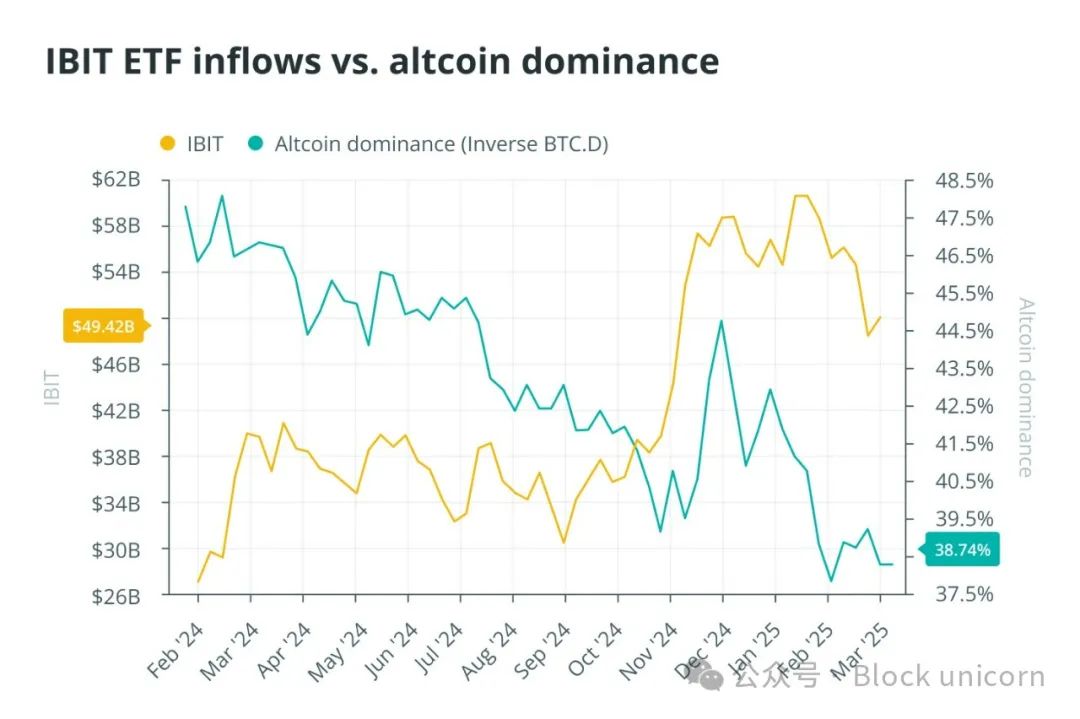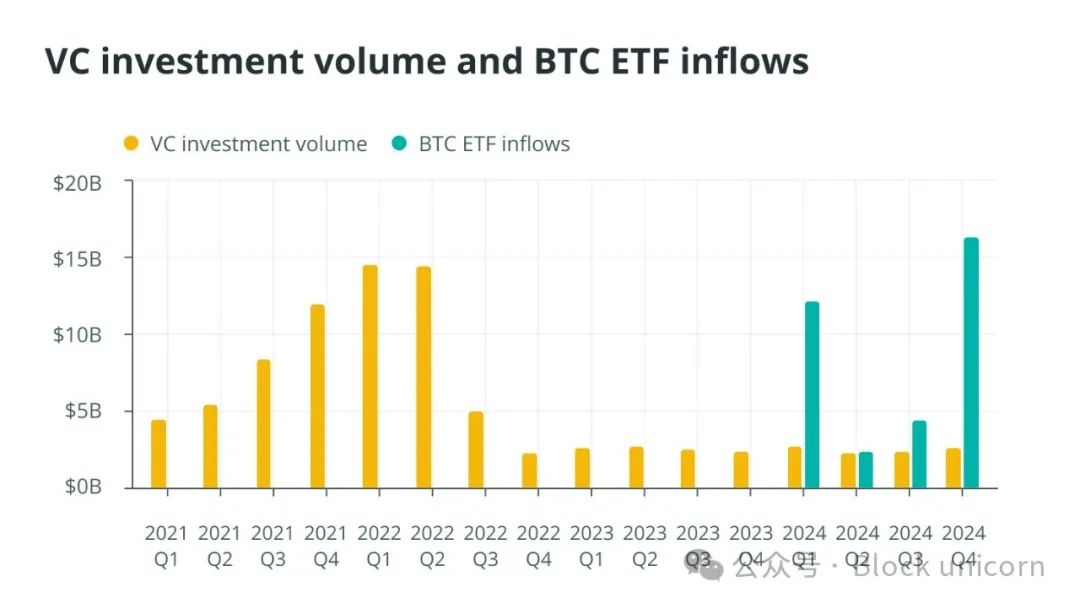Article written by: Bryan Daugherty
Article translation: Block unicorn
Bitcoin exchange-traded products (ETFs) may fundamentally change the concept of “altcoin season” in the crypto market.
For years, the crypto market has followed a familiar rhythm, with capital rotations becoming almost predictable. Bitcoin soars, attracting mainstream attention and liquidity, and then money pours into altcoins. Speculative capital pours into low-cap assets, pushing up their values, and traders excitedly call it "altcoin season."
However, this cycle, once taken for granted, is showing signs of structural breakdown.
Spot Bitcoin exchange-traded funds (ETFs) broke records in 2024, attracting $129 billion in inflows. This has provided retail and institutional investors with unprecedented access to Bitcoin, but it has also created a vacuum that has sucked money away from speculative assets. Institutional investors now have a safe, regulated way to gain exposure to cryptocurrencies without the "Wild West" risks of the altcoin market. Many retail investors have also found ETFs more attractive than searching for the next 100x coin. Well-known Bitcoin analyst PlanB even swapped his actual Bitcoin holdings for spot ETFs.
This shift is happening in real time, and if funds continue to be locked up in structured products, altcoins will face reduced market liquidity and relevance.

Is the altcoin season dead? The rise of structured crypto investing
Bitcoin ETFs provide an alternative to chasing high-risk, low-market-cap assets, where investors can gain leverage, liquidity, and regulatory transparency through structured products. Retail investors, once the main driver of altcoin speculation, can now invest directly in Bitcoin and Ethereum ETFs, which eliminate self-custody concerns, reduce counterparty risk, and align with traditional investment frameworks.
Institutions are more motivated to avoid altcoin risk. Hedge funds and professional trading platforms that once chased higher returns in low-liquidity altcoins can now deploy leverage through derivatives or gain exposure on traditional financial rails through ETFs.
As the ability to hedge through options and futures increases, the incentive to speculate in illiquid, low-volume altcoins has significantly diminished. This trend was further reinforced by the record $2.4 billion of outflows in February and the arbitrage opportunities created by ETF redemptions, forcing the crypto market into an unprecedented level of discipline.

The traditional “cycle” starts with Bitcoin and then moves into the altcoin season. Source: Cointelegraph Research
Will VCs abandon crypto startups?
Venture capital (VC) firms have historically been the lifeblood of the altcoin season, injecting liquidity into emerging projects and weaving grand narratives for emerging tokens.
However, as leverage becomes readily available and capital efficiency becomes a key priority, VCs are rethinking their strategies.
VCs strive to achieve the highest possible return on investment (ROI), but the typical range is between 17% and 25%. In traditional finance, the risk-free rate of capital is the benchmark for all investments, usually represented by the U.S. Treasury yield.
In the crypto space, Bitcoin’s historical growth rate serves as a similar expected return benchmark. It effectively becomes the industry’s risk-free rate. Over the past decade, Bitcoin’s compound annual growth rate (CAGR) has averaged 77%, significantly outperforming traditional assets such as gold (8%) and the S&P 500 (11%). Even over the past five years, including both bull and bear market conditions, Bitcoin’s CAGR has remained at 67%.
Using this as a benchmark, a venture capitalist deploying capital in Bitcoin or Bitcoin-related businesses at this growth rate would have a total ROI of approximately 1,199% over five years, meaning the investment would have increased nearly 12 times.
Although Bitcoin remains volatile, its long-term outperformance makes it a fundamental benchmark for evaluating risk-adjusted returns in the crypto space. With increased arbitrage opportunities and reduced risk, VCs may opt for safer bets.
The number of VC deals fell 46% in 2024, even as overall investment volume rebounded in the fourth quarter. This signals a shift toward more selective, high-value projects rather than speculative funding.
Web3 and AI-driven crypto startups are still attracting attention, but the days of indiscriminate funding for every token with a whitepaper may be numbered. If venture capital further shifts toward structured investments through ETFs rather than investing directly in high-risk startups, new altcoin projects could face serious consequences.
Meanwhile, the few altcoin projects that have made it onto the institutional radar, such as Aptos, which recently filed for an ETF, are the exception rather than the norm. Even crypto index ETFs designed to capture broader exposure have struggled to attract meaningful inflows, highlighting that capital is concentrated rather than dispersed.

Oversupply issues and new market realities
The market landscape has changed. The sheer number of altcoins vying for attention has created a saturation problem. According to Dune Analytics, there are currently over 40 million tokens on the market. An average of 1.2 million new tokens were launched each month in 2024, and over 5 million tokens have been created since the beginning of 2025.
With institutions gravitating toward structured investments and a lack of retail-driven speculative demand, liquidity is no longer flowing into altcoins as it once did.
This reveals a stark truth: most altcoins will not survive. CryptoQuant CEO Ki Young Ju recently warned that without a fundamental shift in market structure, most of these assets are unlikely to survive. “The era of everything going up is over,” Ju said in a recent X post.
In an era where money is locked up in ETFs and perpetual contracts rather than flowing freely into speculative assets, the traditional strategy of waiting for Bitcoin’s dominance to wane before turning to altcoins may no longer apply.
The crypto market is not what it used to be. The days of easy, cyclical altcoin rallies may be replaced by an ecosystem where capital efficiency, structured financial products, and regulatory clarity determine where money flows. ETFs are changing the way people invest in Bitcoin and fundamentally altering the distribution of liquidity across the market.
For those who have built on the assumption that every Bitcoin rally will be followed by an altcoin boom, it may be time to reconsider. As the market matures, the rules may have changed.












